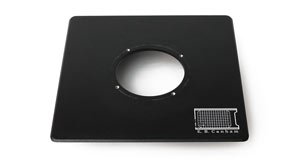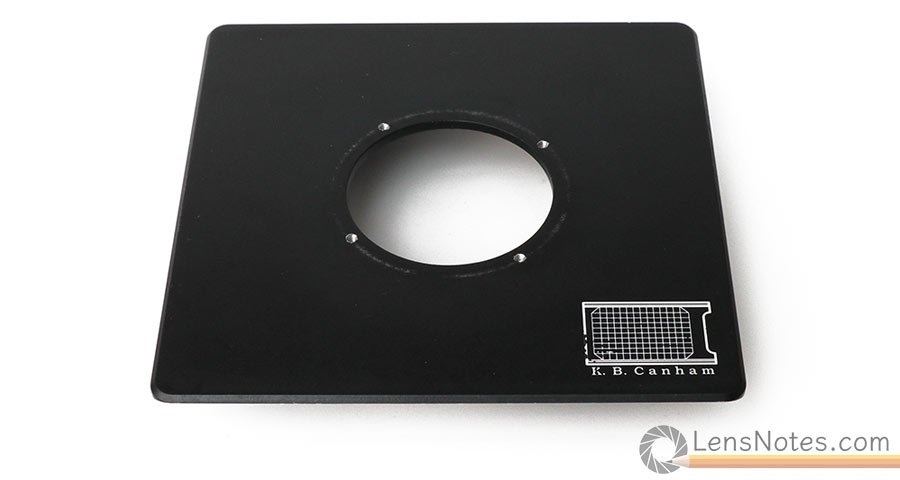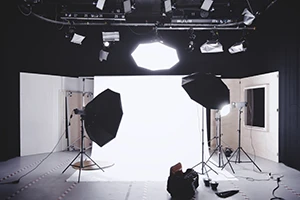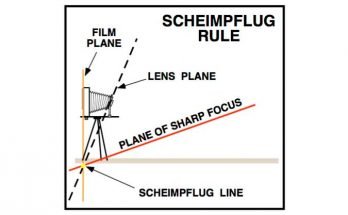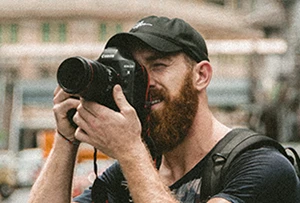What is a Lens Board?
A lens board is a photographic accessory used to attach a lens to a large format camera or an enlarger. Lens boards represent the oldest approach to lens interchangeability in cameras, and as such are a predecessor to contemporary bayonet mount systems.
Usually made of wood, plastic or metal, lens boards can be found in many different shapes and sizes. A typical lens board represents a flat rectangle or square with a hole in the center, much like the Canham unit above. Some designs may feature locating notches, beveled corners and / or stepped edges to fascilitate mounting and light-proofness of the system. The rear (film facing) side of the lens boards are always painted flat black to eliminate any reflections inside the camera body.
How is a lens board used?
There are two stages to using a lens board. When you get a new lens or a new camera, you need to install your lens onto the appropriate lens board. Each one of the lenses you routinely use with your large format camera should be mounted onto a lens board. The mounting procedure is neither fast, nor something you generally want to undertake in the field.
What are standard lens board hole sizes?
Lens boards are universal, and any lens by any manufacturer can be mounted on any board, provided the board is drilled to the necessary size and the lens can physically fit. Because most large format lenses come mounted in leaf shutters, lens board hole sizes are standartized around the shutters.
Lens board holes may be drilled in the center or offset, depending on the manufacturer’s design. An off-center lens board hole may be used to achieve a preset amount of front standard rise or fall to overcome camera design limitations. For example, Linhof Technika 4×5 boards have the shutter hole located off-center to align the optical axis of the lens with the center of the film plane.
Copal
The vast majority of large format lenses made after World War II are mounted in shutters complying with the Copal nomenclature which is as follows:
- Copal #0 – 34.6 mm hole diameter
- Copal #1 – 41.6 mm hole diameter
- Copal #3 – 65 mm hole diameter
- Copal #3s – 64.5 mm hole diameter
Compur
An older lens may come with a Compur shutter, which follow a different sizing convention. However, there are certain overlaps, as you will notice, which show the cross-compatibility built into the systems.
- Compur #00 – 26.3 mm hole diameter
- Compur #0 – 34.6 mm hole diameter
- Compur #1 – 41.6 mm hole diameter
- Compur #2 – 52.5 mm hole diameter
- Compur #3 – 65.0 mm hole diameter
What are the different lens board types?
Flat
Flat lens boards are the simplest and most common type of lens board. They are used for the vast majority of lens and camera combinations. Mounting a lens onto a flat lens board will position the base of the shutter at the same plane as the front standard of the camera.
Recessed
Recessed lens boards are designed to shift the position of the lens into the body of the camera along the optical axis, thus effectively reducing the flange focal distance. Simply put, a recessed board brings the lens closer to the film place. This may be needed if the front and back standards of a view camera cannot get close enough for the lens to reach infinity focus. Even if infinity focus can be achieved, a recessed lens board may be used to allow the bellows to extend a little, thus enabling limited perspective control movements of the front standard. Depending on the camera and bellows, a recessed lens board might be needed with any lens wider than 90mm for the 4×5 format.
These lens boards come in different depths to suit different lenses and cameras. Common recess depths for Linhof recessed boards are 6mm, 12mm and 21mm. Another application of recessed lens boards is to allow certain technical cameras like the Linhof Technika and Wista 45sp to be closed with a lens mounted on them. However, do your research and measurements if you want to do this. Simply mounting any lens onto a recessed board does not mean you will be able to fold your camera with it mounted.
Using a lens mounted in a recessed board can be tricky, as all the controls of the shutter you normally access from the side will be crammed inside the recess. Some manufacturers like Linhof remedy this by equipping their recessed boards with cable release extensions and auxiliary aperture levers and scales.
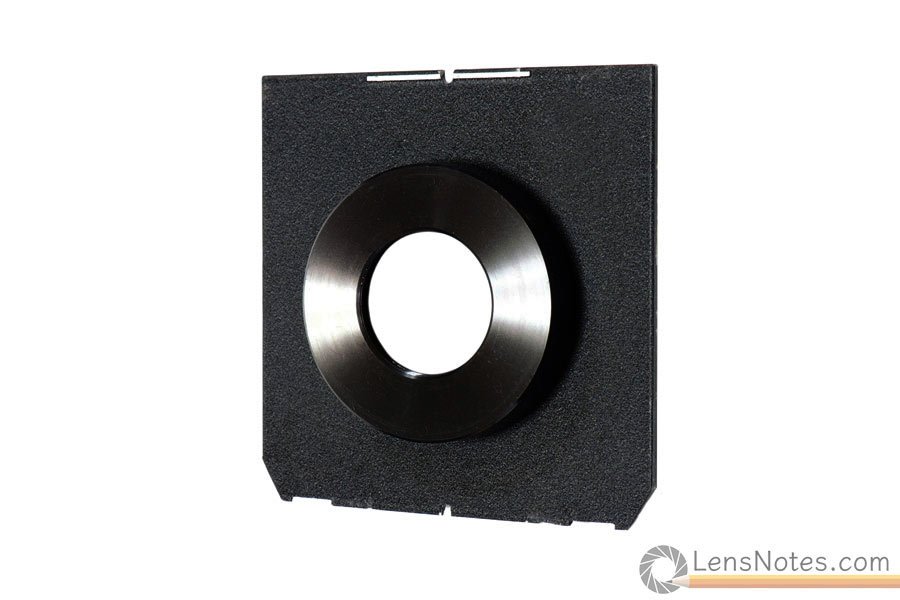
Top-hat
Top hat lens boards, are, unsurprisingly, the exact opposite of recessed siblings. Also known as extension lens boards, they bring the lens further from the film plane, in front of the front standard. They are used when the maximum bellows extension of the camera is not enough to achieve the desired close focus. Top hat lens boards come both as fixed designs and adjustable models. The Wista board pictured above features a threaded flange and replaceable extension rings of various lengths.
Top hat lens boards find another, more limited application in technical cameras like the Linhof Technika or the MPP Micro Technical. Using wide lenses on these cameras brings the front standard back enough for the rails and bed to get into the image. To avoid this, these cameras have the option of dropping the rails down and out of the way. However, to drop down the bed, you must keep the front standard onto the short set of rails that remain inside the camera body. A top hat may be needed in this case to retain the proper flange focal distance.
Beware of changes in operation of the camera that an extension lens board may introduce. Because you are bringing the lens assembly forward, the tilt/swing process of the front standard will be affected. If your camera has axis tilt and/or swing of the front standard, it will not operate as such with a top hat lens boards, because the nodal point of the lens is no longer aligned with the tilt axis. Rise, fall or shift movements will not be affected.
Helicoid
Lens boards with helicoid focusing mounts are, in fact, continuosly adjustable top hat boards. They are sometimes used with wide angle lenses because of the extra precision they provide. In addition, using certain focal lenghts with some technical cameras may be significantly easier with a helical mount.
Furthermore, calibrated helical mounts are one of the best ways to employ zone focusing with a large format camera. For this, however, you will need to get a helical mount specifically calibrated for the lens you will be using. Both Schneider and Rodenstock manufacture helicoid mounts with focus distances and DOF scales for their wider lenses.
Specialist
Some manufacturers make specific lens boards for custom applications. Arca Swiss, for example, make a version of their 110mm square lens board with an electronic Canon EF lens mount, which allows aperture control of electronic lenses.
Another specialist lens board type is the Sinar DB system, which foregoes traditional center-mounted leaf shutter for a behind-the-lens shutter. Based on the traditional Sinar 139.6 mm square lens boards, the DB boards are of the top-hat style, designed to position the whole lens in front of the shutter. Because of this design requirement, Sinar DB lens boards are specific for each lens. In additon, because the lenses have no shutters, they cannot be used on traditional large format cameras without modification.
The Sinar DB system is now discontinued, but it’s heritage continues as Sinar’s current eShutter line-up.
What are the different lens board standards?
There are several popular lens board standards, and they are all based around different manufacturers’ camera designs. There are lens board adapters that can be used to make a camera accept a different (typically smaller) lens board standard. This way, you can use your lenses on cameras by different manufacturers without remounting them into different lens boards.
In addition, many photographers use lens board adapters to save on bulk and weight. For example, the Toyo 810GII uses 158mm square lens boards, which may prove unwieldy to carry. With a lens board adapter, you can use the much smaller and lighter Toyo 110mm square lens boards or even Linhof Technika boards, provided your 8×10 lenses fit on them.
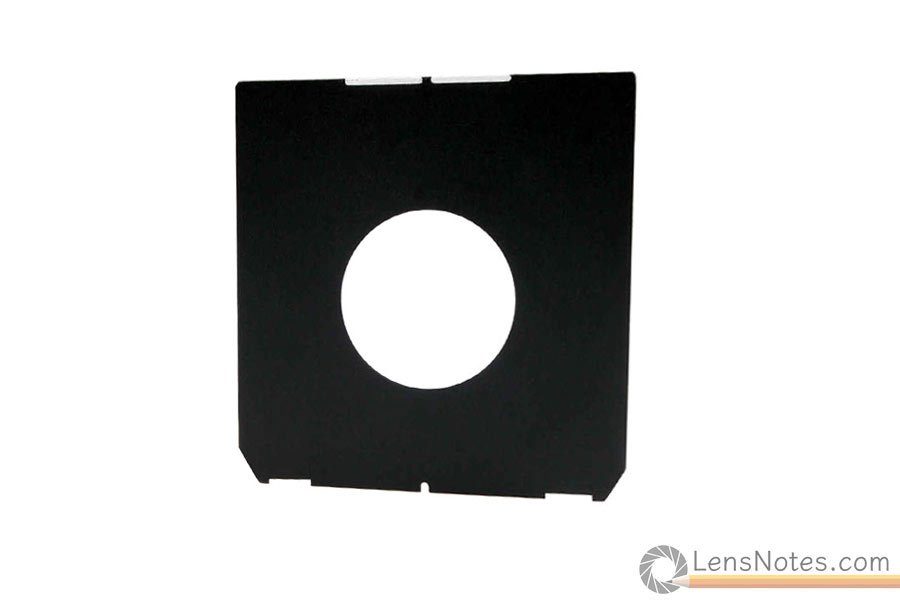
Linhof
Established in 1887, Linhof is the oldest and most popular large format photography equipment manufacturers still in business today. The company has used several lens board designs over the years.
The Technika 4×5 lens board is used on the Technika IV and all subsequent Technika and Technikardan 4×5 cameras. It is also the single most popular lens board standard across the industry. Its compact size helps keep the bulk of your kit to a minimum, something most large format camera packages can definitely use. A more compact lens board is also helpful when you store your lenses, especially if you have a bigger collection, or if you store them in a dry cabinet.
The Technika 4×5 lens board measures 98.2mm x 95.8mm (3.868″ x 3.773″) with a double circular light-trap lip on the back side. The board’s bottom corners chamfered, and there are dual locating notches in the bottom edge. This board is adopted by manufacturers like Wista, Ebony, Tachihara, Walker, Chamonix, Shen-Hao and Inba among others. Pretty much all others offer adapters for their cameras to accept the Technika 4×5 lens boards.
The smaller Technika V Super 69 cameras use a 81.4mm x 74.4mm (3.205″ x 2.93″) lens board with double circular light-trap lip, chamfered top and bottom corners and locating notches in the top, bottom and left edges.
The Linhof Technika also comes in a 5×7 format, which is a bit less common than the 4×5 verison and uses a proprietary lens board. The Technika 5×7 lens board is 130mm square (5.1″) with a circular light-trap lip and a locating notch in the center of the bottom edge.
Older Technika III cameras use a 100mm x 93mm (3.94″ x 3.66″) rectangular lens board with a circular light-trap groove
The Linhof Kardan monorail cameras use a simpler, 162mm square (6.37″) lens board with a square light-trap step and rounded corners.
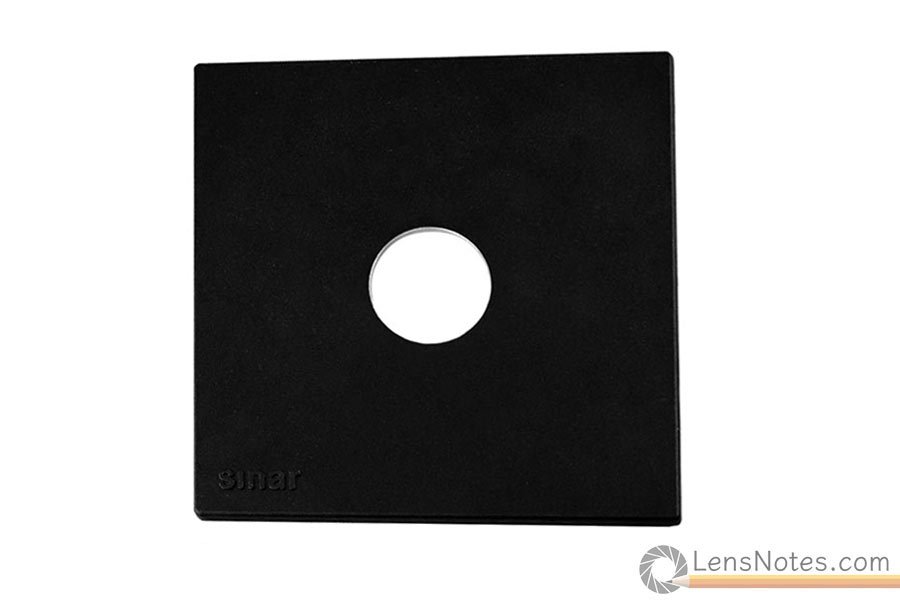
Sinar
Established in 1948, Sinar is another long-standing large format photography equipment manufacturer, and as such has used several lens board standards over the years.
The most popular Sinar lens board type is a 139.6 mm square (5.497″) board with a square light-trap groove on the back. This lens board standard is also used in SKG Phillips and Horseman cameras.
Aware of the benefits of a more compact system, Sinar also offers a smaller lens board. Used on some of their field-oriented cameras like the P3 and the New Vue, the smaller board is 100mm square (4″) with a stepped edge all-round and a light-trap groove on the back.
Deardoff
Deardoff was one of the first large-format camera manufacturers, with production starting in the 1920s and spanning several decades. Deardoff manufacture was halted in the 80s, and was resumed briefly a few years ago with a limited production run made of cameras assembled from old stock spares. As of today, no new Deardoff cameras are made, but plenty of the originals are still kicking.
All Deardoff cameras are made of wood, with the vast majority of it being mahogany. Most of the original lens boards are also made of wood, most commonly mahogany veneered plywood.
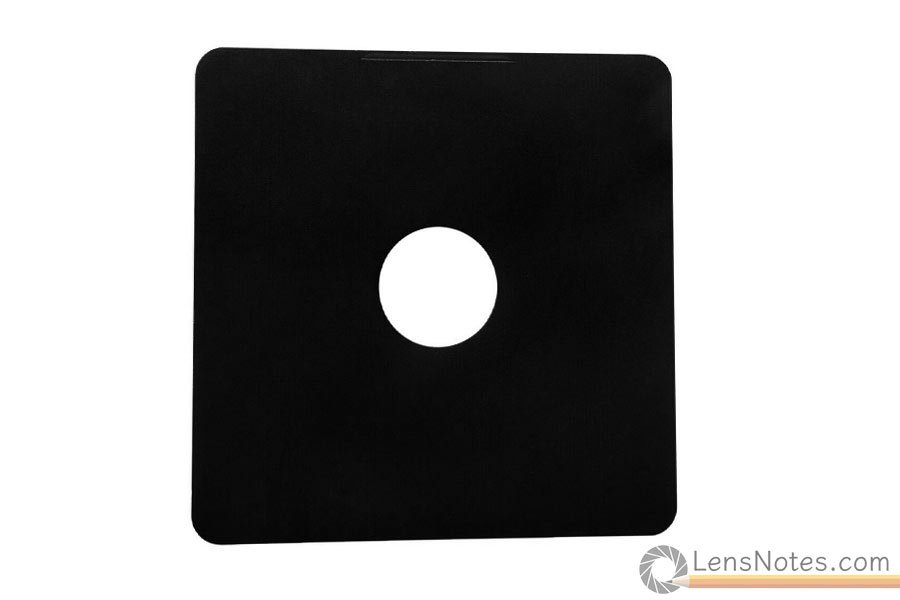
Arca Swiss
Arca Swiss lens boards come in three different sizes. The smallest one, used on their smaller F-line and M-line, is a 110mm square (4.33″) with rounded corners and square light-trap step. The bigger size, reserved for their larger monorails, is a 140mm square (5.51″) with the same round corner and square light-trap design. The largest Arca Swiss lens board size is 171mm square (6.729″) with dual light-trap lips on the back. It may or may not have an indentation along the top edge (pictured above) into which the lens board lock nests once the board is on the camera.
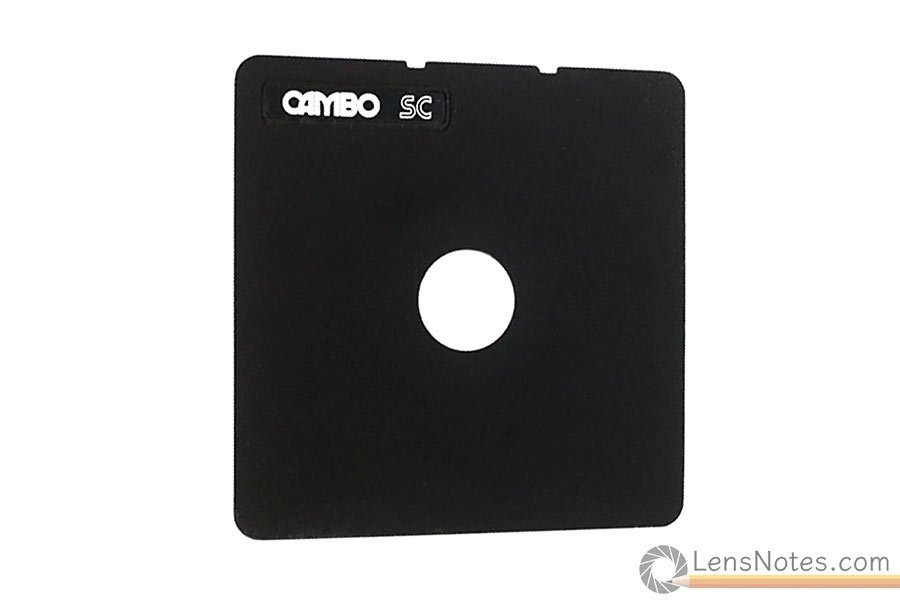
Cambo
Cambo lens boards come in two sizes. The smaller one, used on their 2×3 view cameras, is a 123mm square (4.86″) with rounded corners, two locating notches on the top corner and a square light-trap groove on the back.
The larger Cambo lens board, used on their 4×5 monorails, measures a 163mm square (6.41″) with two locating notches on the top corner and a square light-trap groove on the back.

